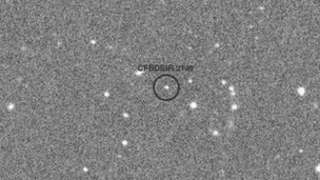Astronomers have spotted a “rogue planet” – wandering the cosmos without a star to orbit – 100 light-years away.
Recent finds of such planets have suggested that they may be common, but candidates have eluded close study.
The proximity of the new rogue planet has allowed astronomers to guess its age: a comparatively young 50-120 million years old.
The planet, dubbed CFBDSIR2149-0403, is outlined in a paper posted online to appear in Astronomy and Astrophysics.
Rogue planets are believed to form in one of two ways: in much the same way as planets bound to stars, coalescing from a disk of dust and debris but then thrown out of a host star’s orbit, or in much the same way as stars but never reaching a full star’s mass.
One tricky part is determining if rogue planet candidates are as massive as the “failed stars” known as brown dwarfs, further along in stellar evolution but without enough mass to spark the nuclear fusion that causes starlight.
Either way, the objects end up free of a host star’s gravity. Given that most planets we know of are found through the effects they have on their host star’s light, pinning down rogue planets has proven difficult.
An international team went on a vast hunt for the planets using the Canada France Hawaii Telescope on Hawaii’s Mauna Kea and the Very Large Telescope (VLT) in Chile, looking for the infrared light that warm, young planets give off – and they came up with just one candidate.
“This object was discovered during a scan that covered the equivalent of 1,000 times the [area] of the full moon,” said study co-author Etienne Artigau of the University of Montreal.
“We observed hundreds of millions of stars and planets, but we only found one homeless planet in our neighbourhood.”
But crucially, the new find appears to be moving along with a similarly itinerant group of celestial objects, called the “AB Doradus moving group” – a collection of about 30 stars which are of roughly the same composition and are believed to have formed at about the same time.
Because CFBDSIR2149-0403 appears to be moving with the group – to a certainty of 87% – astronomers believe it too formed with the stars, about 50 -120 million years ago.
It is this estimate of age that allows astronomers to use computer models of planet evolution to make further guesses as to the planet’s mass and temperature.
The team believe it has a temperature of about 400C and a mass between four and seven times that of Jupiter – well short of the mass limit that would make it a likely brown dwarf.
What remains unclear is just how the planet came to be – the tiny beginnings of a star, or planet launched from its home? Study co-author Philippe Delorme of the Institute of Planetology and Astrophysics of Grenoble, said that the latter implied a great many planets like it.
“If this little object is a planet that has been ejected from its native system, it conjures up the striking image of orphaned worlds, drifting in the emptiness of space,” he said.
Source: BBC news

































Leave a Comment
You must be logged in to post a comment.